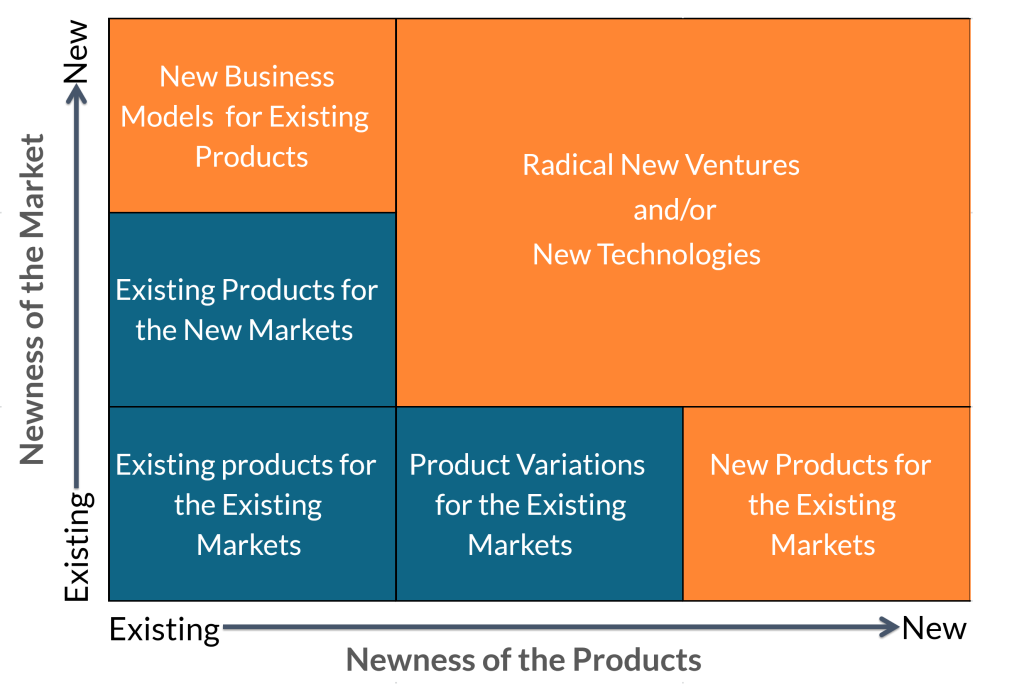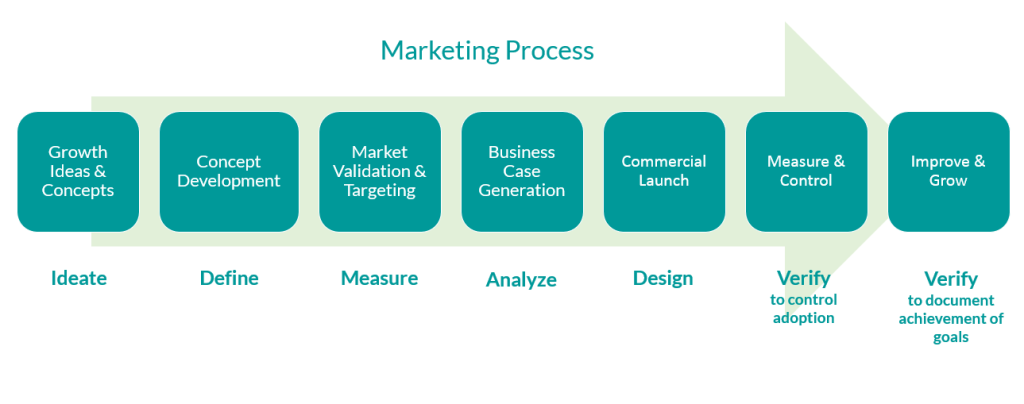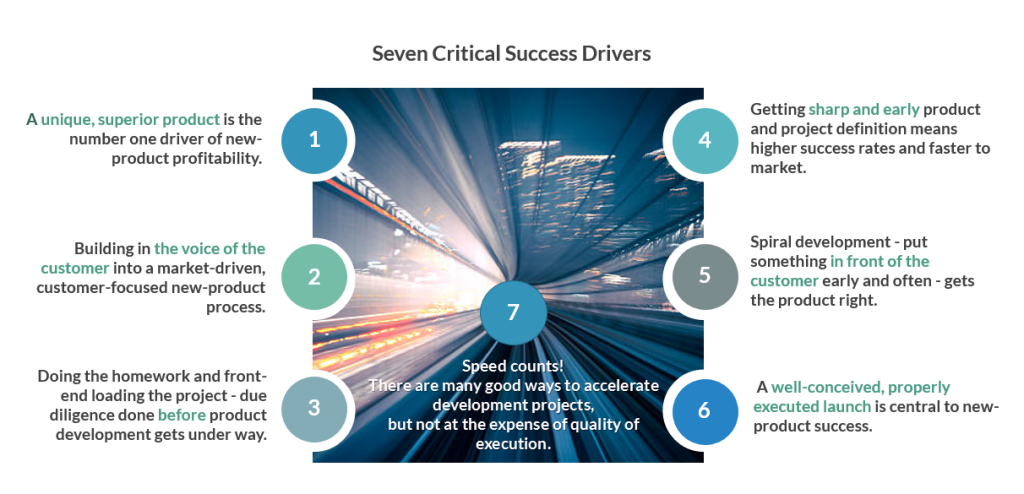B2B companies are increasingly finding that their existing product-driven businesses are having difficulty growing and differentiating themselves from their competition. In addition, their quest to find new markets and new products to expand their portfolio is becoming more complex, both because of the speed of competitive following and because of the confusion in incorporating these new arenas into their established organization.
The Old Marketing Process
Historically, B2B companies have been product-driven: Their offering has been limited to core products and product-related services pushed through the value-adding chain to the ultimate demand driver. They focused their efforts on creating value for their immediate customers and depended on those immediate customers to capably create value for downstream customers and, ultimately, the end user/consumer. Often, the objectives of each level in the value-adding chain are at odds with each other, creating a vertical competitive environment even greater than in-kind competition.
For a B2B company to better serve their existing customers and more successfully address the dynamics of appropriate levels in the value chain, they must develop a market orientation and marketing competency. Market orientation expands the business potential to participate beyond their existing product sell efforts by focusing on the value systems of the value-adding chain and redefining their offering to meet those critical values of the demand drivers.
The New Process—Marketing Innovation
There are two paths to business growth, both of which are built on a foundation of strong leadership and data.
Profitability through improved market engagement or operational efficiency
- Segmentation
- New value propositions
- Premium pricing
- Adjacent market penetration
- Process optimization
Innovation through new market and new offering growth
- New offerings and/or markets
- New business models—the value-adding chain role
- Blue Oceans
When we break it down, the two sources of growth are greater profitability and something new. Of course, neither path can happen without sound business leadership. Improvements in market engagement deliver profitability or innovation.
The graphic to the right compares business products (existing vs. new) and markets (existing vs. new). The lowermost left quadrant represents existing products for existing markets, whereas the uppermost right quadrant represents the pinnacle of “newness”—radical new ventures and/or new technologies for new markets. In between, there are
- New business models for existing markets
- Existing products for new markets
- Product variations for existing markets
- New products for existing markets

As you move outward in any direction, you are enhancing the growth of your business. Your strategy defines the direction your “arrow” will move, as well as how far it goes. Your business model impacts all of these strategy elements.
Improve Odds for Success and Accelerate Benefits
When the market is new and the products are new, you end up with radical new ventures and/or new technologies. New product development needs to be driven by facts from your customers. All the steps need to be visited on every project. Some projects are quick to complete when you have the facts.

Establish growth ideas or concepts that represent potential opportunities for your business. This includes conceptualizing your opportunity and screening and prioritizing to identify opportunities to validate.
Develop an initial business concept to validate. Create a hypothesis that is evergreen and meant to be tested and changed, then test your hypothesis in the marketplace. This will help you understand your marketplace and validate the market potential of your opportunity.
Analyze your business case generation.
Business model
Offering definition
Engineering development
Pricing and positioning strategy
Business case
Integrated action and project plan
Understand what it will take to win and assess the value to your business. Do an overall assessment of the value of your potential offering. This will generate a recommendation to either go forward with the offer, redirect the offer, or stop the offer altogether. There is a way to connect a market-driven, differentiated offering to the requirements language of R&D, engineering, and operations. You need to translate the market-driven learnings into an actionable framework for your internal organization to do their work.
The 7 Critical Success Drivers

- A unique, superior product is the number one driver of new product profitability
- Build in the voice of the customer in a market-driven, customer-focused new product process
- Do the homework and front-end load the project; do due diligence before product development gets underway
- Getting sharp and early product and project definition means higher success rates and faster to market
- Spiral development—putting something in front of the customer early and often—gets the product right
- A well-conceived, properly executed launch is central to new product success
- Speed counts! GET IN FRONT OF THE CUSTOMER EARLY AND OFTEN! There are many good ways to accelerate development projects, but not at the expense of execution quality.
Market Analytics – The Key to Success
Marketing is only as good as the research supporting it. Marketing intelligence should drive all marketing decisions. It should be strategic (actions about the market), and it should be tactical (actions in the market). You need to understand the relationships between the customer, the company’s offering, and the environment.
What you really need is market analytics—the capture of all the relevant market data that has been integrated, analyzed, and interpreted specifically to more completely evaluate all your options for growth. Market analytics not only recognizes the interdependence of the four Ps (Product, Promotion, Price, and Place), but also models that interdependence in a way that enables you to consider multiple options and the associated risks.
What is required of the marketing team for an effective market analytics effort?
Know what you need. Decide what you need to learn and how you will use those learnings in your project. With the strategic objectives in mind, a list of key issues needs to be addressed. These include competitive positioning, importance of actors, key outcomes, pricing, customer attitudes, and issues. Some of the elements of these should already be known, but some may still be hidden.
Design your knowledge capture approach. The three critical steps here are to
- Think “outcomes,” or what the specifiers in the market may want to happen as a result of interacting with you. They buy products and services to help them get their jobs done.
- Do a qualitative market assessment to identify the hidden elements and validate that the list of potential outcomes are correct. The key here is to discover what specifiers value and the criteria they use to measure supplier performance.
- Design your quantitative market study in a way that you can both measure the market and test concepts. A good quantitative design employs exercises in which the respondent is asked to make choices on what is important to them, and identifies the difficulty a respondent has achieving their most important outcomes. The design should capture the respondents’ beliefs and attitudes about the primary topic, competitive behavior, and willingness to act as desired.
Compile the learnings—and get the complete story. A well-designed market analytics study should provide you with a “causal” or prescriptive view of the market. These learnings should be translated into actionable implications. A key benefit to this approach is models that enable your team to do “what if” analyses.
Provide multiple perceptions of the marketplace. The market consists of different groups of customers, which can be referred to as segments. These segments may be based on differences in key market drivers, such as outcome performance, attitudes, and feature benefits, or on slicing by key demographic and sales factors. By segmenting by behavioral factors, you can both identify multiple value propositions and select target groups that best fit your capability to deliver value. Analyze by segment.
Develop and test compelling alternatives. Effective market analytics should generate potential for alternative strategies. Your team should have some hypotheses about alternatives before embarking on a market analytics study. Those alternatives should be tested in the qualitative phase, then incorporated into the quantitative study. In compiling the learnings, and gaining the multiple perceptions, you can generate analytics on each alternative and conduct risk assessments.
A market analytics study incorporates a comprehensive assessment and analysis of the critical components of your business’s interaction with a defined market. Obviously, the design is dependent upon the nature of your market and the competitive environment. However, for most business to business markets, the study should be able market analytics to answer most or even all of these questions:
How important are our product attributes to the market and how do the major competitors (including us) perform against those attributes?
What benefits (outcomes) do the specifying customers in the market want, and how do they perceive their primary suppliers performing relative to those outcomes?
How can we distinguish between what customers say is important and how they actually behave compared to their stated importance?
How do these attributes and outcomes vary by different segments of the market, or what segments are derived from different responses to attribute and outcome importance?
How will price changes impact competitive share, and how does that differ among the defined segments based on attribute and outcome importance?
What is the right balance between price and share that maximizes our profits?
How would customers value a new product concept that we are considering bringing to the market, and what would they be willing to pay for it?
How would customers value some new offering features we may bring to the market, and how does that value differ across our customer base?
Conclusion
Leadership must be clear on what marketing must do well to generate growth and profits for the company, and stay steadfast in installing a market orientation. The marketing team must know how to do the marketing work and have the right tools to do the work effectively. Change begins with a clear vision on what marketing is, how it works, and how it will enable the greater.
How do you get started making marketing work in your company?
- Form a marketing leadership steering team to determine overall drivers for and the needs of the business to engage in the marketing process.
- Refine and customize your marketing process to best meet those needs.
- Engage leadership in enrolling the organization in marketing as a key work process for business success. (A diagnostic to determine both the attitudes and skills of the organization is available to help the leadership understand the state (size and dimensions) of the organization capacity and capabilities.)
- Initiate the family of marketing competency workshops across the organization.
- Select a unit to use the marketing process in developing a marketing strategy/plan for that unit to determine both the barriers/issues and potential for reward using marketing.
- Establish key people to steward key elements of the marketing process and begin the work of developing best practices.

Ron Sullivan
Ron Sullivan is a Senior Partner at Breakthrough Marketing Technology. He has worked with many businesses on innovation, new product development processes, strategy, building new business models, channels and distribution, and pricing optimization. He has significant expertise in study design, data analysis, and market intelligence.

Pamela Roach
Pamela Roach is CEO of Breakthrough Marketing Technology. She is dedicated to our mission of enabling businesses to make decisions based on fact. She has designed, collected, analyzed, and delivered the intelligence necessary to produce insights into the motivations, attitudes, and outcomes that characterize multicultural targets. In addition to her work at Breakthrough, she also teaches graduate students Integrated Marketing and Media Campaigns at NYU School for Professional Studies.


